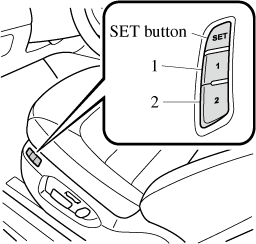

Driving Position Memory (Some Models)
The desired driving position can be called up after programming the position.
The following driving positions can be programmed.
-
Driver’s seat position (seat slide, height adjustment, front edge of seat bottom, seat recline)
Refer to Adjusting the Driver's Seat (Search).
-
Active driving display (display position, brightness level, display information)
Refer to Active Driving Display (Search).
Do not place fingers or hands around the bottom of the seat while the seat memory function is operating. The seat moves automatically while the seat memory function is operating and fingers or hands could get pinched and injured.

A driving position can be programmed or operated using the buttons on the side of the seat or the key.
-
Lumbar support adjustment cannot be programmed.
-
A driving position can be programmed to the buttons on the side of the seat and the key in use for driving the vehicle.
-
If the vehicle has been serviced and the battery leads disconnected, the programmed seat positions will have been erased. Re-programme the seat positions.
Programming
-
Make sure the parking brake is on.
-
(Automatic transaxle)
Make sure the selector lever is in the P position.
-
Start the engine.
-
Adjust the seat and the active driving display to the desired driving position.
-
Press the SET button on the seat until a beep sound is heard 1 time.
-
Perform one of the following settings within 5 seconds of completing step 5 above:
-
Programming using a button on the side of the seat
Press the button you want to programme, either button 1 or 2, until a beep sound is heard 1 time.
-
Programming using the key
Press the key
 button until a beep sound is heard 1 time.
button until a beep sound is heard 1 time.
-
To move the driving position to a programmed position
(Using a button on the side of the seat)
-
Make sure the parking brake is on.
-
(Automatic transaxle)
Make sure the selector lever is in the P position.
-
Start the engine.
-
Press the programming button for the driving position you want to call up (button 1 or 2).
-
A beep sound is heard when the driving position adjustment is completed.
-
If the driving position movement is not changed, only the beep sounds.
-
A seat position can be called up even with the engine not running.
-
The driving position adjustment is cancelled in the following cases:
-
Any of the seat adjustment switches is operated.
-
The SET button is pressed.
-
Programming button 1 or 2 is pressed.
-
The key
 button or
button or  button is operated.
button is operated. -
The vehicle starts moving.
-
The active driving display is adjusted.
-
(Using a programmed key)
-
Unlock the doors by pressing a request switch or the key
 button.
button. -
After unlocking the doors, the seat position adjustment begins within 40 seconds of opening the driver's door, and a beep sounds when the operation is finished.
-
Make sure the parking brake is on.
-
(Automatic transaxle)
Make sure the selector lever is in the P position.
-
Start the engine.
-
The active driving display adjustment begins.
-
If there is no driving position movement, a beep is not heard.
-
The driving position adjustment is cancelled in the following cases:
-
Any of the seat adjustment switches is operated.
-
The SET button is pressed.
-
Programming button 1 or 2 is pressed.
-
The key
 button or
button or  button is operated.
button is operated. -
The vehicle starts moving.
-
The active driving display is adjusted.
-
Erasing programmed driving positions
(Erasing the driving positions programmed to the key)
-
Switch the ignition OFF.
-
Press the SET button on the side of the seat until a beep sound is heard 1 time.
-
After the beep sounds, press the key
 button within 5 seconds until a beep sound is heard 1 time.
button within 5 seconds until a beep sound is heard 1 time.




